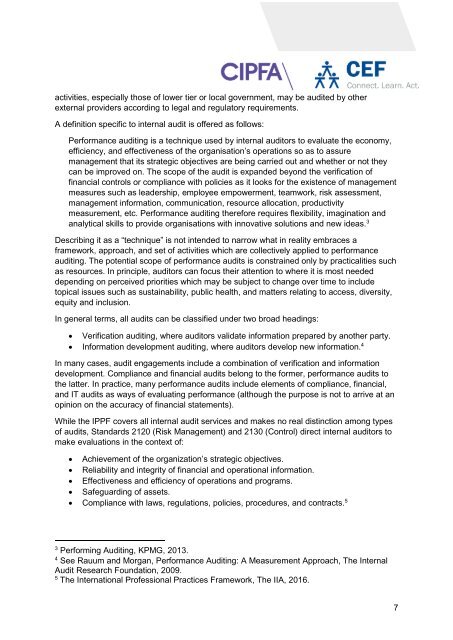You also want an ePaper? Increase the reach of your titles
YUMPU automatically turns print PDFs into web optimized ePapers that Google loves.
activities, especially those of lower tier or local government, may be audited by other<br />
external providers according <strong>to</strong> legal and regula<strong>to</strong>ry requirements.<br />
A definition specific <strong>to</strong> internal audit is offered as follows:<br />
<strong>Performance</strong> auditing is a technique used by internal audi<strong>to</strong>rs <strong>to</strong> evaluate the economy,<br />
efficiency, and effectiveness of the organisation’s operations so as <strong>to</strong> assure<br />
management that its strategic objectives are being carried out and whether or not they<br />
can be improved on. The scope of the audit is expanded beyond the verification of<br />
financial controls or compliance with policies as it looks for the existence of management<br />
measures such as leadership, employee empowerment, teamwork, risk assessment,<br />
management information, communication, resource allocation, productivity<br />
measurement, etc. <strong>Performance</strong> auditing therefore requires flexibility, imagination and<br />
analytical skills <strong>to</strong> provide organisations with innovative solutions and new ideas. 3<br />
Describing it as a “technique” is not intended <strong>to</strong> narrow what in reality embraces a<br />
framework, approach, and set of activities which are collectively applied <strong>to</strong> performance<br />
auditing. The potential scope of performance audits is constrained only by practicalities such<br />
as resources. In principle, audi<strong>to</strong>rs can focus their attention <strong>to</strong> where it is most needed<br />
depending on perceived priorities which may be subject <strong>to</strong> change over time <strong>to</strong> include<br />
<strong>to</strong>pical issues such as sustainability, public health, and matters relating <strong>to</strong> access, diversity,<br />
equity and inclusion.<br />
In general terms, all audits can be classified under two broad headings:<br />
Verification auditing, where audi<strong>to</strong>rs validate information prepared by another party.<br />
Information development auditing, where audi<strong>to</strong>rs develop new information. 4<br />
In many cases, audit engagements include a combination of verification and information<br />
development. Compliance and financial audits belong <strong>to</strong> the former, performance audits <strong>to</strong><br />
the latter. In practice, many performance audits include elements of compliance, financial,<br />
and IT audits as ways of evaluating performance (although the purpose is not <strong>to</strong> arrive at an<br />
opinion on the accuracy of financial statements).<br />
While the IPPF covers all internal audit services and makes no real distinction among types<br />
of audits, Standards 2120 (Risk Management) and 2130 (Control) direct internal audi<strong>to</strong>rs <strong>to</strong><br />
make evaluations in the context of:<br />
Achievement of the organization’s strategic objectives.<br />
Reliability and integrity of financial and operational information.<br />
Effectiveness and efficiency of operations and programs.<br />
Safeguarding of assets.<br />
Compliance with laws, regulations, policies, procedures, and contracts. 5<br />
3<br />
Performing <strong>Audit</strong>ing, KPMG, 2013.<br />
4<br />
See Rauum and Morgan, <strong>Performance</strong> <strong>Audit</strong>ing: A Measurement Approach, The Internal<br />
<strong>Audit</strong> Research Foundation, 2009.<br />
5<br />
The International Professional Practices Framework, The IIA, 2016.<br />
7
















